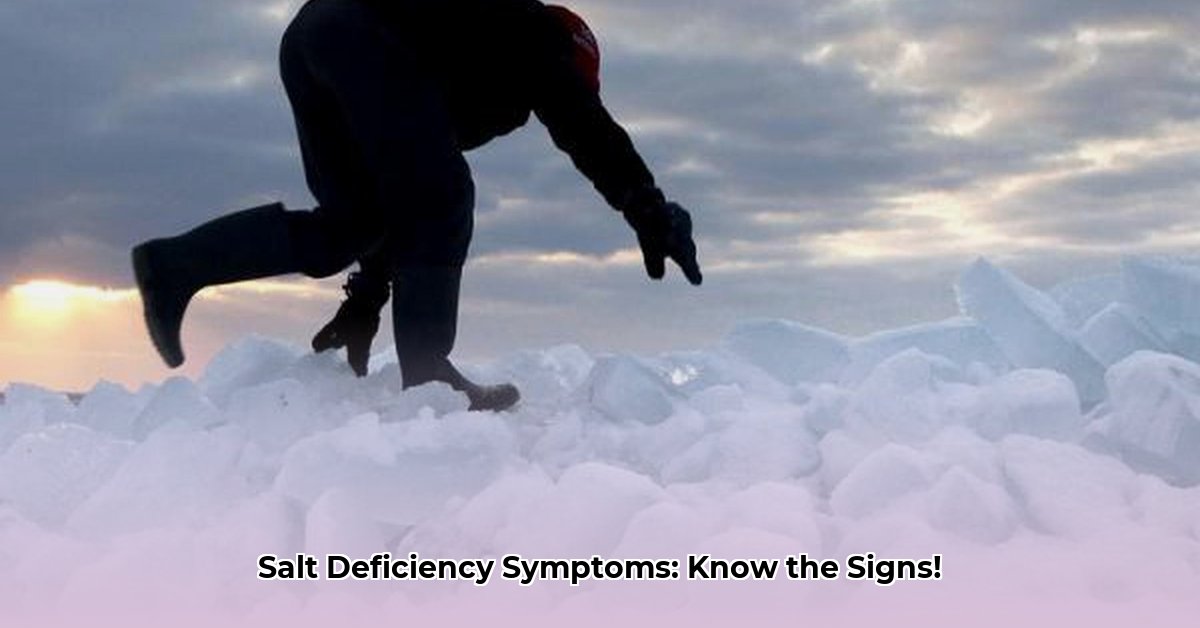
Feeling a bit under the weather? Maybe unusually tired, with a headache, or a queasy stomach? These could be signs of hyponatremia, often called Zout Tekort in Afrikaans – a low sodium level in your blood. Understanding the symptoms is crucial, so let's explore what hyponatremia is, its causes, and most importantly, what you can do.
Verstaan Lae Natrium: Wat Veroorsaak Dit?
A low sodium level means your blood's sodium concentration is too low. This disrupts your body's delicate chemical balance. Several things can cause it: drinking too much water (diluting the sodium), underlying medical conditions like kidney disease, heart failure, or liver cirrhosis, certain medications, excessive sweating, or vomiting.
Remember, your body is a finely tuned machine, and sodium plays a vital role in nerve and muscle function. Too little disrupts this balance. While not always serious, a Zout Tekort needs attention.
Die Tekens Opspoor: Algemene Zout Tekort Symptomen
Hyponatremia symptoms vary depending on how quickly your sodium levels drop and the severity. Mild cases might only cause fatigue and mild headaches. More severe cases can lead to confusion, nausea, seizures, or even a coma. Seek immediate medical help if you suspect a problem.
Here are some common symptoms to watch out for:
- Hoofpyn (Headache): A persistent or severe headache is a common warning sign. It could be a dull ache or a sharp, throbbing pain.
- Naarheid en Braking (Nausea and Vomiting): Frequent nausea or vomiting can be a sign.
- Spier Swakheid (Muscle Weakness): Muscle cramps or weakness are possible. You might struggle with certain movements.
- Moegheid en Lusteloosheid (Fatigue and Lethargy): Feeling unusually tired and listless, even after a good night's sleep.
- Verwarring en Disoriëntasie (Confusion and Disorientation): Mental impairment can occur in severe cases. You might lose your bearings or become confused.
- Epileptiese aanvalle (Seizures): In severe cases, this is a very serious sign requiring immediate medical attention.
Wat om te Doen as jy 'n Zout Tekort Vermoed:
If you experience several of these symptoms, see a doctor immediately. Do not attempt self-treatment. Diagnosing and treating hyponatremia requires professional medical care. Your doctor will likely perform blood tests to confirm a diagnosis. Treatment depends on the severity and underlying cause.
Remember: Prompt action is vital. Early intervention prevents potentially dangerous complications.
Voorkoming is Belangrik: Die Handhawing van Natrium Balans
Maintaining a healthy sodium balance is essential. Avoid excessive water intake, especially during exercise. Eat a balanced diet with enough salt and other electrolytes. If you're on medication that affects your electrolytes, talk to your doctor. Regular health check-ups are beneficial, especially if you have risk factors.
'n Woord van Waarskuwing: Dit is Nie Mediese Advies Nie
This information is for general knowledge only and is not a substitute for professional medical advice. If you're concerned about your sodium levels or are experiencing any of the mentioned symptoms, consult a doctor immediately. They can provide an accurate diagnosis and treatment plan.
How to Differentiate Acute and Chronic Hyponatremia
Hyponatremia's severity depends on how quickly sodium levels drop. Acute hyponatremia develops rapidly (within 48 hours), often with severe neurological symptoms like seizures or coma. Chronic hyponatremia develops slowly (over days or weeks), potentially with milder symptoms like nausea or headaches. Treatment differs significantly; rapid correction is dangerous in chronic cases. Both require medical attention. Have you ever wondered why early diagnosis is so critical in managing hyponatremia? This is because early intervention can significantly improve outcomes.
"The speed of onset is crucial in determining the treatment approach," explains Dr. Anya Sharma, Nephrologist at Johannesburg General Hospital. "Acute cases require immediate intervention, while chronic cases demand a more gradual correction to prevent serious complications."
Three pivotal points to remember:
- Acute hyponatremia develops rapidly, often within 48 hours.
- Chronic hyponatremia develops slowly, over days or even weeks.
- Treatment strategies vary significantly depending on the type of hyponatremia.
Actionable Steps:
- Monitor your symptoms: Pay attention to headaches, nausea, muscle weakness, and fatigue.
- Consult a doctor: Do not try to treat hyponatremia yourself. Immediate medical attention is crucial.
- Follow your doctor's instructions: Adhere closely to any treatment plan your doctor recommends.
This article has provided a comprehensive overview of hyponatremia symptoms and management. Remember, early detection and prompt medical care are key to successful treatment and improved health outcomes.